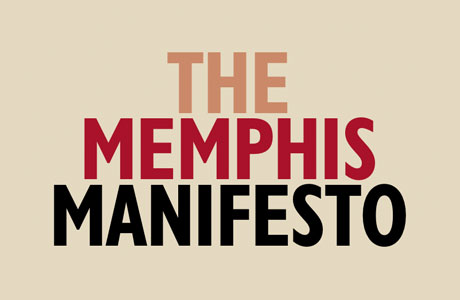Ten years ago, Memphis was ground zero for discussions by workers connected to creative industries, and they had the goal of developing a call to action for cities wanting to attract and retain them.
It was called the Memphis Manifesto Summit, co-sponsored by Memphis Tomorrow and Mpact Memphis and conceived by Carol Coletta, president of Coletta & Company and now vice-president for community and national initiatives for the Knight Foundation, who hosted it with the now ubiquitous Richard Florida.
Attending the two and half days of debate, discussions, presentations, and breakout meetings were the “Creative 100” – a group of creative thinkers nominated from across the U.S. and that swelled to 150 with the addition of Memphians. Participants were diverse, including youthful entrepreneurs, web designers, community activists of all ages, museum and cultural officials, economic development experts, digital film directors, and college students. They came from 48 cities in the U.S. and Canada, with delegations from Cincinnati, St. Louis, Tampa, Milwaukee and Puerto Rico.
Speakers included Kip Bergstrom, executive director of Rhode Island Economic Policy Council; Bill Bishop, reporter on special projects team at Austin American-Statesman; Joe Cortright, economist and author of “Economics of Being Different”; Kristy Edmunds, artistic director for Portland Institute for Contemporary Art; Radhika K. Fox, senior associate at PolicyLink; Adam Gordon, editor-in-chief of The Next American City; Colin Jackson, president and CEO of Epcor Centre for the Performing Arts in Calgary; Andrew Medd, executive director of Canada25; Seth Mnookin, Newsweek senior writer; Walker Smith, president of Yankelovich Partners; Mary Jo Waits, associate director of Morrison Institute for Public Policy at Arizona State University; and Mara Walker, vice-president of Americans for the Arts.
Cities of Ideas
The summit discussion and outcomes informed Ms. Coletta’s impressive body of work in talent development, creative placemaking, and city-building, and it has been cited in Mr. Florida’s work. The summit produced a document called the Memphis Manifesto, and it was applied by downtown development agencies, cultural and arts groups, and economic development organizations across the U.S.
Back then, the goals of the Summit were ambitious but essential: to acquaint an influential group of thinkers with Memphis, to attract widespread traditional and nontraditional media coverage, to link Memphis’ name to a milestone action on creativity, to establish our city as a center for creativity and innovative thinking, to inspire a group of Memphians to carry out the principles and leverage the Manifesto in their recruitment of creative workers and development of public policy.
Presentations and discussions dealt with ambitious themes and spotlighted specific programs in cities across the U.S. while workshops hammered out consensus, but after considering ways to create “cities of ideas,” attractors for creative workers and the leverage points for creativity, the delegates opted for overriding principles rather than the programmatic.
Positive Publicity
National columnist Neal Peirce wrote: “The Memphis conferees weren’t just feathering their own nest, calling in their manifesto for cities, for example, to favor a ‘creative ecosystem’ featuring arts and culture, nightlife, the music scene, artists and designers, lively neighborhoods, vibrant downtowns, open and green space, density, and quality public spaces. To the sponsors’ surprise, they also added spirituality as part of their creative ecosystem. And quickly they voted to ‘embrace diversity’ – the idea that a mix of people of different ethnicities, races, and backgrounds creates an especially creative mix of ideas, expressions, and talents that enrich communities.”
And speaking to the importance of the Summit, he added: “The vision of young creatives assuming responsibility is of immense relevance in American communities at this moment of our history. And at the Memphis sessions, a constant theme was that any community can put together a progressive, youth-oriented strategy for growth.”
All of this is context, and the question remains to be answered about how well Memphis did in addressing the mandates of the manifesto. Here’s what it said:
The Memphis Manifesto: Building a Community of Ideas
Preamble:
Creativity is fundamental to being human and is a critical resource to individual, community and economic life. Creative communities are vibrant, humanizing places, nurturing personal growth, sparking cultural and technological breakthroughs, producing jobs and wealth, and accepting a variety of life styles and culture.
The Creative 100 are committed to the growth, prosperity and excellence of communities, and all who live and work there.
The Creative 100 believe in the vision and the opportunities of a future driven by the power of ideas. Ideas are the growth engines of tomorrow, so the nurturing of the communities where ideas can flourish is the key to success. Ideas take root where creativity is cultivated and creativity thrives where communities are committed to ideas.
Creativity resides in everyone everywhere so building a community of ideas means empowering all people with the ability to express and use the genius of their own creativity and bring it to bear as responsible citizens.
This manifesto is our call to action.
Principles:
The Creative 100 are dedicated to helping communities realize the full potential of creative ideas by encouraging these principles:
1) Cultivate and reward creativity. Everyone is part of the value chain of creativity. Creativity can happen at anytime, anywhere, and it’s happening in your community right now. Pay attention.
2) Invest in the creative ecosystem. The creative ecosystem can include arts and culture, nightlife, the music scene, restaurants, artists and designers, innovators, entrepreneurs, affordable spaces, lively neighborhoods, spirituality, education, density, public spaces and third places.
3) Embrace diversity. It gives birth to creativity, innovation and positive economic impact. People of different backgrounds and experiences contribute a diversity of ideas, expressions, talents and perspectives that enrich communities. This is how ideas flourish and build vital communities.
4) Nurture the creatives. Support the connectors. Collaborate to compete in a new way and get everyone in the game.
5) Value risk-taking. Convert a “no” climate into a “yes” climate. Invest in opportunity-making, not just problem-solving. Tap into the creative talent, technology and energy for your community. Challenge conventional wisdom.
6) Be authentic. Identify the value you add and focus on those assets where you can be unique. Dare to be different, not simply the look-alike of another community. Resist monoculture and homogeneity. Every community can be the right community.
7) Invest in and build on quality of place. While inherited features such as climate, natural resources and population are important, other critical features such as arts and culture, open and green spaces, vibrant downtowns, and centers of learning can be built and strengthened. This will make communities more competitive than ever because it will create more opportunities than ever for ideas to have an impact.
8) Remove barriers to creativity, such as mediocrity, intolerance, disconnectedness, sprawl, poverty, bad schools, exclusivity, and social and environmental degradation.
9) Take responsibility for change in your community. Improvise. Make things happen. Development is a “do it yourself” enterprise.
10) Ensure that every person, especially children, has the right to creativity. The highest quality lifelong education is critical to developing and retaining creative individuals as a resource for communities.
We accept the responsibility to be the stewards of creativity in our communities. We understand the ideas and principles in this document may be adapted to reflect our community’s unique needs and assets.
The (participants) commit to our communities and each other that we will go back to our communities to infuse these ideas into our social lives and public policies and share the accomplishments with each other so that we all can move forward and succeed together in a more creative existence.





When the best the ‘creatives’ can come up with is “convert a no climate into a yes climate” and “make things happen,” then it’s no wonder this effort flopped, died, and then flopped and died again.
Creative thinking should not be boiled down to meaningless cliches.
That was the manifesto. In the meetings and breakout sessions, the creatives thought of all kinds of initiatives and ideas that they then took back to their respective cities and built an agenda around. The manifesto was the skeleton of principles on which the agenda hung, and apparently, it worked because it became the guidepost to some interesting work done in various places. Also, Richard Florida added it to his book, the Rise of the Creatives, so apparently for a lot of people, it was far from meaningless.